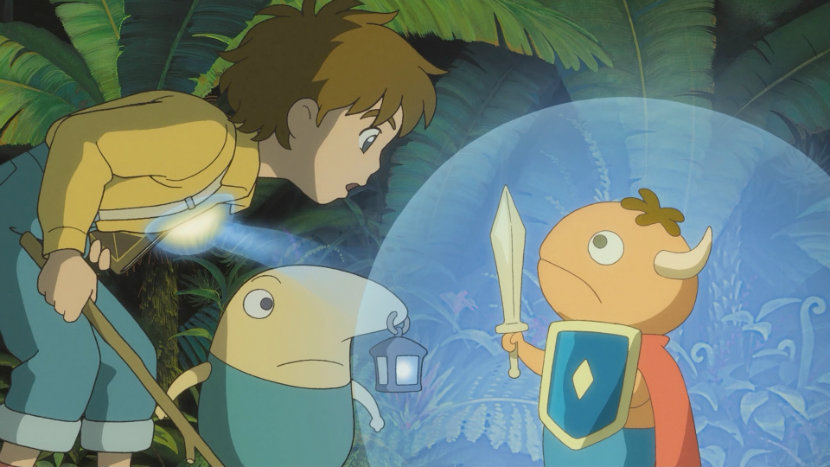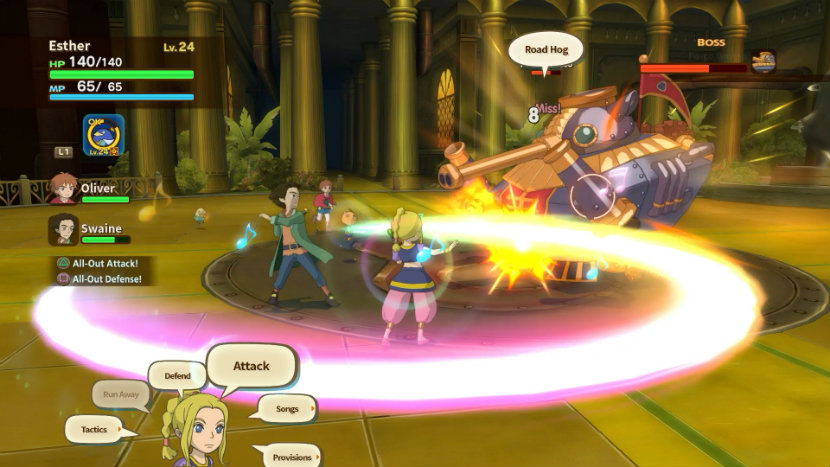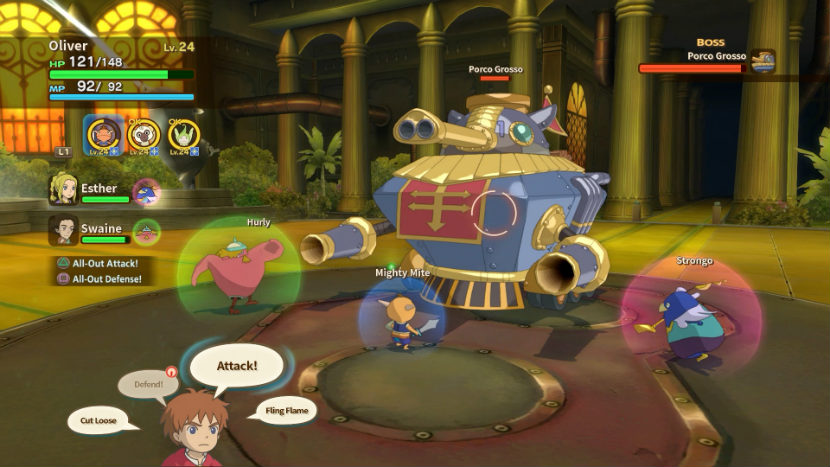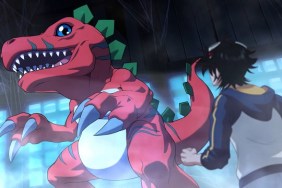Alright folks, buckle up; if you’re one of the many JRPG enthusiasts who loved Ni no Kuni back on the PS3, this review won’t be for you. This release is just Ni no Kuni but better-looking, and if that sounds great to you, then you’re in for a good time. Ni no Kuni: Wrath of the White Witch Remastered is a straight-up enhanced port of the PS3 original, running at a smooth 60 frames per second at 1080p on a standard PS4. It doesn’t quite reach 4K/60 on a PS4 Pro, but it can do 4K/30 with a 1440p option for the faster frame rate. Otherwise it’s the same game, with no extra bonuses or amenities. Normally that sort of a release might be difficult to assign a score to, depending on what a critic might expect from the average re-release (especially since the Switch version apparently needs some work). Luckily, yours truly hasn’t actually played Ni no Kuni substantially before, so your boy jumped in here with a fresh set of eyes. I can see why the PS3 version had the impact it did, but as a common resident of this specific genre space, I was surprised to find myself a little underwhelmed.
Movie Magic

Studio Ghibli has a special kind of power as a studio. It is, frankly, the only anime studio that has a cultural hold on the scale it does, with many folks over here in the west knowing what “Studio Ghibli” means even if they aren’t anime fans otherwise. Hayao Miyazaki and his teams and understudies cranked out masterpiece after masterpiece, developing a house style built on an unmatchable foundation. Even when there’s an occasional miss, the craft and artistry in the average Ghibli movie (in animation alone) stands out among peers. So when Level-5, a developer that had been building a reputation thanks to projects like Dragon Quest VIII, announced a collaboration with an anime studio so powerful Disney was shelling out big bucks for Hollywood voice actors, people over here noticed.
The buzz for Ni no Kuni was ridiculous, especially during a time when JRPGs were losing their luster with larger audiences, and localizations were relatively sparse. But after all the noise and hype, Bandai Namco came through with a western release, and slight controversy over special editions aside, fans and critics alike ate it up. From animated cutscenes produced by Studio Ghibli, to a Joe Hisaishi soundtrack and a story that targeted feelings of childhood nostalgia, Ni no Kuni: Wrath of the White Witch hit all the right notes to stand out. So much so that we recently saw a sequel, which was almost just as well-received. But the sequel, aside from losing the Ghibli backing, had another major difference from its older sibling. The combat gameplay moved from a Pokemon-like, pseudo real-time, menu-based system to a more straightforward action/RPG. And there’s a reason for that, in my estimation.
Ni no Kuni’s battle system, the part of the game you’ll spend the most time in, seems confused about what it wants to be. This game came out in the late 2000s, at a time when developers, critics, and even some players had convinced themselves traditions like turn-based combat weren’t any good. This was proven wrong later, but not before Ni no Kuni itself was caught in the crossfire. This game, which is full of color, whimsy, and heart, displays a severe lack of confidence under the hood. To support my argument here, I need look no further than… Ni no Kuni. No, not the sequel, the other one. The one you can’t pick up at a GameStop.
Thank Goodness We Got Over This

The original Ni no Kuni is actually two games. Before it hit PS3, Level-5 released a Nintendo DS game titled, Ni no Kuni: Dominion of the Dark Djinn (rough translation, there isn’t an official localization). The DS version and PS3 version were in development around the same time, but the focus was on getting the DS version out first because that was the dominant platform. And if you take a look at the DS version (which was fan translated late last year), you can see a lot of DNA that moved on to later Level-5 projects, particularly Yokai Watch. While the console Ni no Kuni shares similar story beats and even music in some cases, the core gameplay is entirely different.
Aside from a gimmick involving a physical spellbook players needed to refer to, Ni no Kuni on DS was a Dragon Quest-inspired, turn-based JRPG. It still had the monster collecting, but battles played out in a straightforward manner with choosing commands and having the time to think about them. Sure, it isn’t as “unique,” but it makes plenty of sense, especially in that monster-collecting space. That genre benefits a lot from more methodical, tactical play. On the other hand, the PS3 (and subsequently PS4) Ni no Kuni takes some of the ideas from the DS game, but shifts them around into something more active. But it isn’t entirely active, as there are key limitations in place. In fact, based on some weird choices, there are actually less options in the moment to moment play despite Ni no Kuni’s console iteration looking and feeling more complex.
In the DS version, while you can only have one monster (or Familiar in game terms) out at a time, but both Oliver and Drippy (the dude with the serious nose piercing) also participate in battle. In the console version, Drippy hangs out on the sidelines, and you can only control either Oliver or one of the familiars. But regardless of your active character, everyone shares the same HP/MP pool. This means you’ll either need to be careful with how you use your resources, or keep hella stocked on restorative items. On one hand, encouraging less conservative play (especially with MP items) is a neat touch, but at the same time managing your characters and skills is fumbly, especially since the Familiars have a time limit. It charges back up once they go on the bench, but you’re still forced to swap between characters, regardless of the battle context.
The part I really didn’t like is how navigating Ni no Kuni’s physical combat space works. You can move freely within the “arena,” which is more or less a big circle. You choose your menu commands in real time (think Kingdom Hearts, sort of), and swapping characters pauses the action. Every action has a cooldown, and basic attacks go for a little while as a timer ticks down (even if your character is positioning and not actively swinging). Sometimes, there are situations in which you can maneuver around an enemy to attack a weak point, or in a parallel situation, you might need to move around to avoid a shield or some other armor. Meanwhile, enemies attack you in turn, and sometimes have tells for their big moves (which you can dodge or block by various means).
It all feels fine and responsive, and looks pretty cool in motion especially with the beefed-up frame rate. However, there isn’t a clear, tangible sense of the space you occupy versus the space an enemy occupies, and how those two concepts intersect. You can move around, but it seems like enemies can hit you regardless (like a MMO), or perhaps moving further away makes them miss – that seems to be the case at times but the game never offers an explanation. Areas of effect aren’t really a factor, until sometimes they suddenly are, and you also get to fight your characters’ instincts to attack enemies head-on when you need to run and find a weak point. It’s painfully obvious to me that Ni no Kuni was designed first as a turn-based game, then molded and hammered into something else to justify itself to a confused idea of what the console JRPG-playing audience was at the time. The DS version’s gameplay makes more sense with what’s happening in that game, and the more honest real-time shtick in Ni no Kuni II makes more sense as well. I’m not suggesting trying new things is a problem (Final Fantasy VII Remake seems to be nailing it), but this set of new things feels misguided.
You Can Catch ‘Em All, I Guess. If You Want To

Speaking of what’s happening, Ni no Kuni also fumbles the ball a bit with its monster collecting. There’s a lot of stuff you can mess around with to build your stable, but a lot of the ideas don’t really land in a way that feels cohesive. It’s also hard to want to do anything but build physical attackers since using spells in combat doesn’t feel good. There are evolutionary chains for familiars, but the items required just drop from battles and evolving just happens from tinkering in menus. There are stat-boosting items, but you can just buy them in shops for cheap and there are ill-defined limitations to them that feel like boosting units in a gacha game. There’s a Pokemon-like move pool, but it’s also weirdly limited and once again, clashes with the combat systems. Once again I see why this was abandoned for the sequel, and those energies were spent elsewhere (shout out again to Yokai Watch).
I had fun with Ni no Kuni: Wrath of the White Witch Remastered, but I found myself knocking it down to easy so I could just hit things without thinking too hard, and going through the more compelling sights and sounds without having to dive into a bunch of clumsy systems I didn’t enjoy engaging with. The Ni no Kuni world is so much fun, and the Ghibli-produced cutscenes are not quite up to par with the studio’s theatrical work, but not too far off. I love the sequel, and the DS game is something I’m definitely looking forward to checking out. But as far as this game is concerned, it feels more like Level-5 figuring out what it wanted to be in the modern era. While it’s clumsy and frustrating compared to its peers, it’s still such an ambitious and wholesome project it’s hard not to be into it regardless.
Ni no Kuni: Wrath of the White Witch Remastered review code provided by publisher. Version 1.00 reviewed on a Standard PS4. For more information on scoring please see our Review Policy.
-
It's a great port - smooth as silk on a standard PS4
-
Everything that is appealing about a Studio Ghibli production, but also a video game
-
No extras or bonuses - purely a performance/resolution bump
-
Fumbly systems and mechanics that don't feel like a cohesive vision








